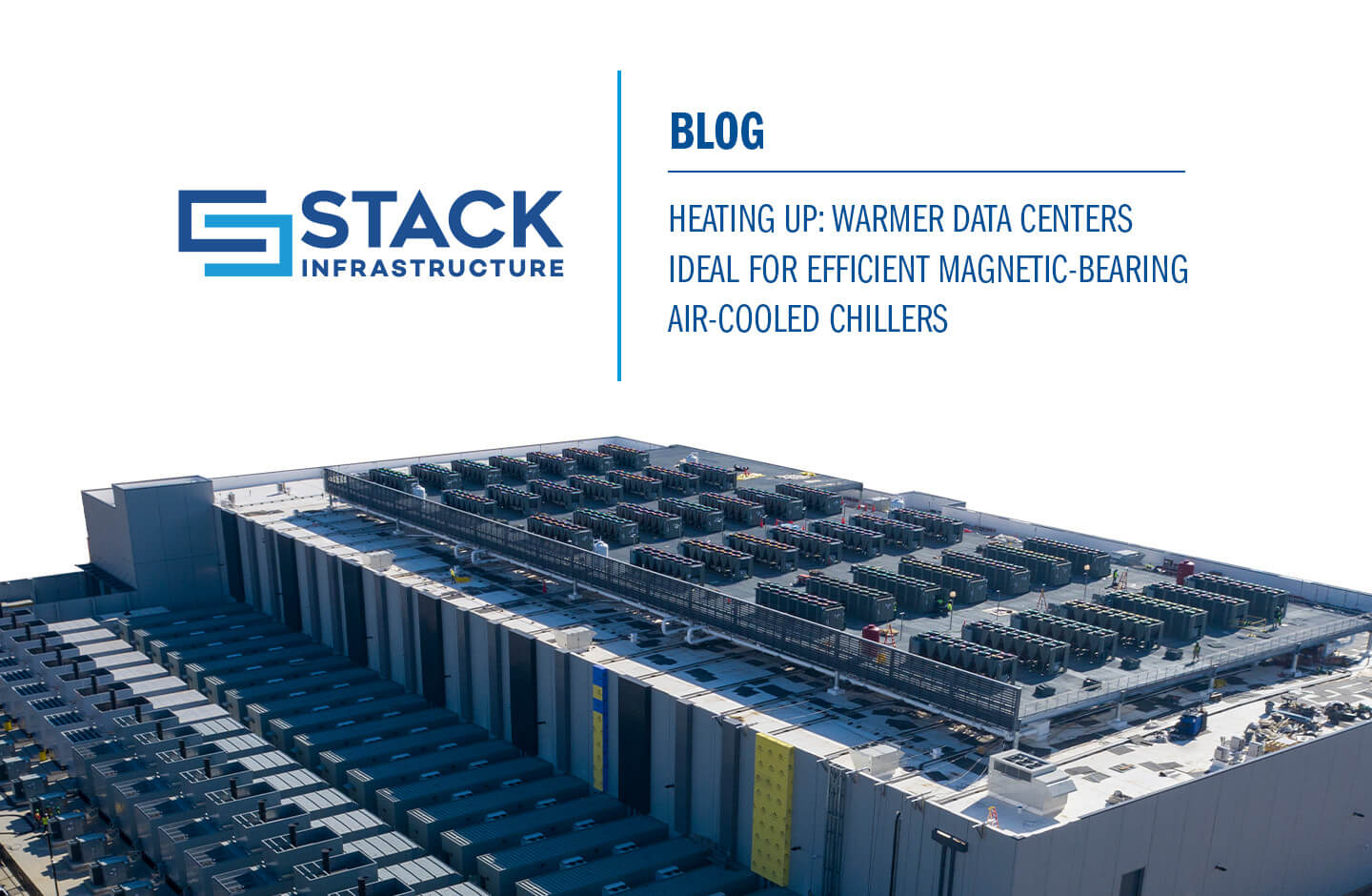Heating Up: Warmer Data Centers Ideal for Efficient Magnetic-Bearing Air-Cooled Chillers

Have you ever heard of Glasstron by Sony? Unless you are a real tech head, you probably have not. Released in 1996, the Glasstron was a portable head-mounted display with dual LCD screens and earphones. The technology at the time could not properly support the device, and by 1998, Sony released the last of the Glasstron models. While the early head-mounted display did not gain widespread popularity, it laid the groundwork for today’s virtual reality (VR) and mixed reality headsets that began trending in the 2010s.
Like Glasstron, magnetic-bearing compressors were invented in the mid-1990s but would become a more relevant technology years later. According to the American Society of Heating, Refrigerating and Air-Conditioning Engineers (ASHRAE), Danfoss was the first to commission an environmentally friendly compressor prototype in 1995 in response to the phase-out of refrigerants under the Montreal Protocol. A few years later, these magnetic-bearing centrifugal compressors were implemented into commercial chillers, whose benefits included being quieter, smaller, lighter, and more efficient than other chillers.
Magnetic-bearing centrifugal compressors were primarily used in cooler environments or in water-cooled systems because of the inherently lower condensing temperatures. Water scarcity drove the digital infrastructure industry towards the use of air-cooled chillers—which traditionally utilize screw compressors that operate well in warm conditions—to avoid evaporating onsite. However, as the industry adopts warmer and warmer indoor operating conditions for servers, data centers can utilize magnetic bearing compressors in air-cooled chillers to provide a measurable improvement in both energy and cost efficiency, yielding a more sustainable and, ultimately, more optimal data center.
The Purpose of a Compressor in Data Center Cooling
Compressors are essential to data center cooling because they make it possible to reject the heat generated by the IT equipment to the environment. Similar to a refrigerator or air-conditioner in your home, these mechanical devices compress refrigerant gas and reject heat into an ambient environment that is warmer in order to cool a fluid.
There are four main types of compressors:
- Reciprocating compressors are more common in petrochemical and industrial applications (but not in data centers).
- Scroll compressors are utilized in commercial or residential applications with smaller capacities.
- Screw compressors were the most common compressors used in the data center industry for a considerable amount of time and are still prevalent today.
- Centrifugal compressors include magnetic-bearing compressors and are becoming more common in data centers.
Screw and centrifugal compressors have their distinct advantages and were, therefore, applied in data center cooling solutions.
Why Centrifugal Compressors Are More Efficient
Centrifugal compressors tend to be more energy and cost efficient than screw compressors. Further, since the shaft in a magnetic-bearing compressor levitates in a magnetic field, there is no friction to cause energy losses.
On the other hand, screw-type compressors need oil for lubrication, which causes friction and becomes an operational issue. In cold weather, the oil thickens, causing resistance on the rotor and ultimately leading to energy loss. If you have ever tried to fill your tires at a gas station in the winter, you may have experienced this. If the compressor was out of service or would not start, it is likely that it failed to function because the oil was too thick to flow properly. The same happens when screw compressors are used in a cold environment.
To solve this problem, many data centers previously used dry-coolers that were also costly and inefficient. Now, if screw compressors are in use, they are often coupled with a free-cooling or economizer coil, which allows the compressor to turn off when the environment is too cold. While this is necessary for the compressors to function—and is required by international energy code in almost every jurisdiction with a few exceptions—these systems are expensive and fundamentally inefficient.
The lack of friction in magnetic-bearing compressors eliminates the need for oil, circumventing the issues associated with cold compressor starts or economizers, reducing operational costs, and extending the overall life of the equipment.
Why Screw Compressors Are Traditionally More Popular in Air Chillers
The entire purpose of a compressor in a refrigeration circuit is to increase the pressure of the refrigerant gas between the evaporator and the condenser. This pressure differential is referred to as “compressor lift” and is directly proportional to temperature differential.
As a positive displacement machine, a screw compressor does not allow gas to flow back through the compressor. When these machines are used with air chillers in very warm ambient conditions such as those found in Dallas, TX or Phoenix, AZ, the screw compressors are able to generate extremely high pressures to effectively reject the heat into the environment.
While centrifugal compressors are more efficient, they do not operate well in higher temperatures and cannot create sufficient compressor lift when used in air-cooled environments. A magnetic-bearing air-cooled chiller in Phoenix, for example, may experience chiller surge, where the high-pressure gas would overcome the speed of the compressor and start flowing backwards from the condenser and into the evaporator. Think of the last time you attempted to blow up a balloon. As the pressure increases inside, it becomes more difficult to add any more air. This everyday experience is the same as chiller surge in a magnetic-bearing air-cooled chiller in too hot of an environment.
For this reason, data centers have more commonly used centrifugal compressors in water-cooled systems, which have naturally lower condensing temperatures than air-cooled systems. However, the scarcity of water has more recently driven data centers away from using water for evaporation. Consequently, air-cooled chillers utilizing screw compressors became much more prevalent in the data center industry.
Why Magnetic-Bearing Compressors in Data Centers Are More Relevant Now Than Ever
The data center industry previously sacrificed energy efficiency for compressor lift sufficiency. However, with new industry design standards, this sacrifice is no longer necessary.
The industry has pushed the operating envelope of computing equipment to warmer and warmer temperatures. The water temperatures used to cool modern data centers are 20°F+ warmer than what was required a decade ago. As a result, chillers do not have to produce the extremely cold water that was previously necessary. This reduces the burden of compressor lift and enables magnetic-bearing compressor technology to handle the application and operate effectively at higher temperatures without the risk of chiller surge.
Additionally, since magnetic-bearing compressors do not require oil to function and will not gel up in cold environments, they can run just as effectively at low temperatures. Therefore, data centers can maximize the efficiency of magnetic-bearing compressors in both hot and cold environments.
Moving Forward with Magnetic-Bearing Air-Cooled Chillers
While screw compressors were traditionally used in air-cooled chillers to capitalize on operational performance in warmer environments, recent advances in standards and technology have made the centrifugal compressor a more efficient and more universal option for data center cooling.
STACK Infrastructure is capitalizing on this efficient technology to improve operational performance and sustainability targets. Magnetic-bearing compressors will be deployed in air-cooled chillers within STACK’s latest Northern Virginia data centers—a model location to assess success within both hot and cold temperatures—to reduce annual chiller energy consumption and ultimately improve power usage effectiveness (PUE). The capital expense is an investment into our long-term sustainability journey.
The data center industry is becoming increasingly more energy efficient, and magnetic-bearing compressors are a critical component of the sustainability equation. Not everyone has yet opted for magnetic-bearing air-cooled chillers, but the technology is on track to increase in popularity and proficiency as companies prioritize more advanced sustainability goals.
By Brian Medina, PE, Director of Construction
April 6, 2023




